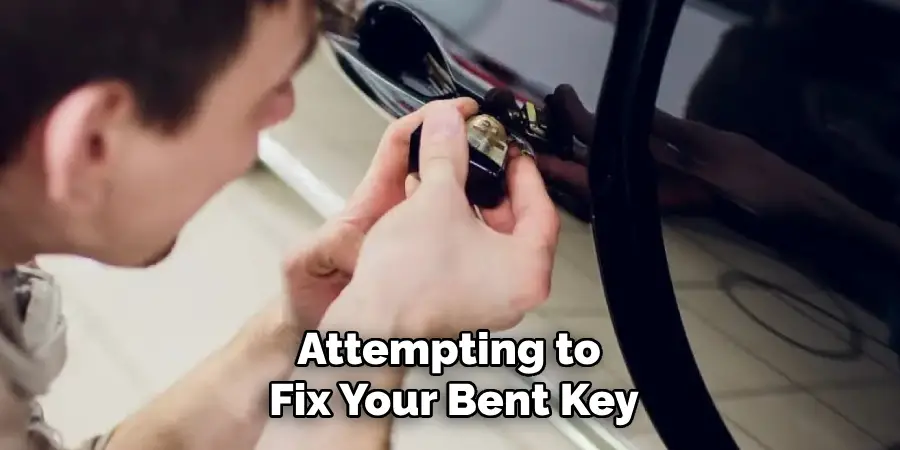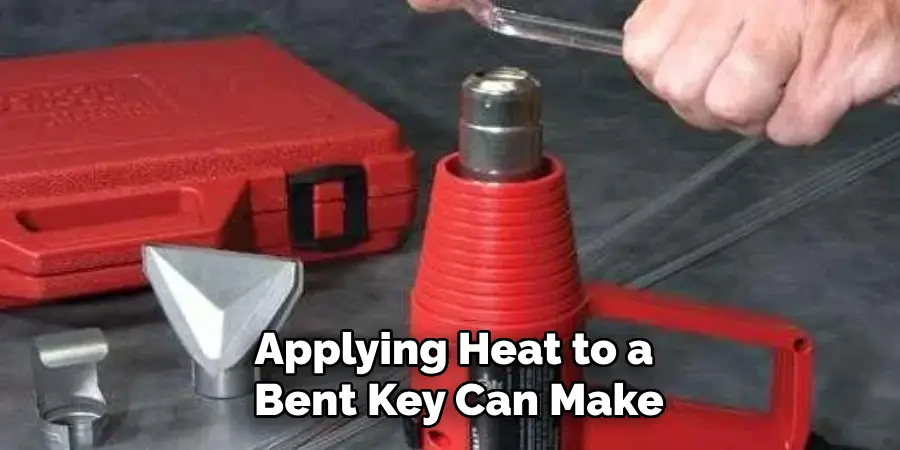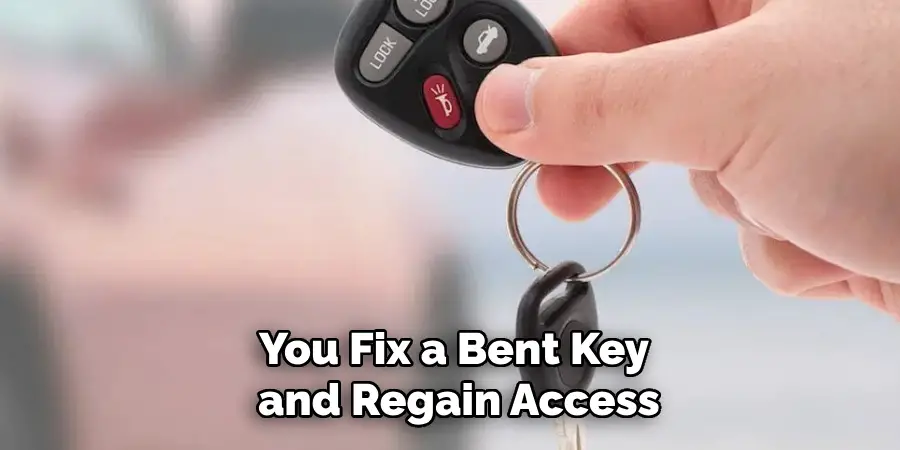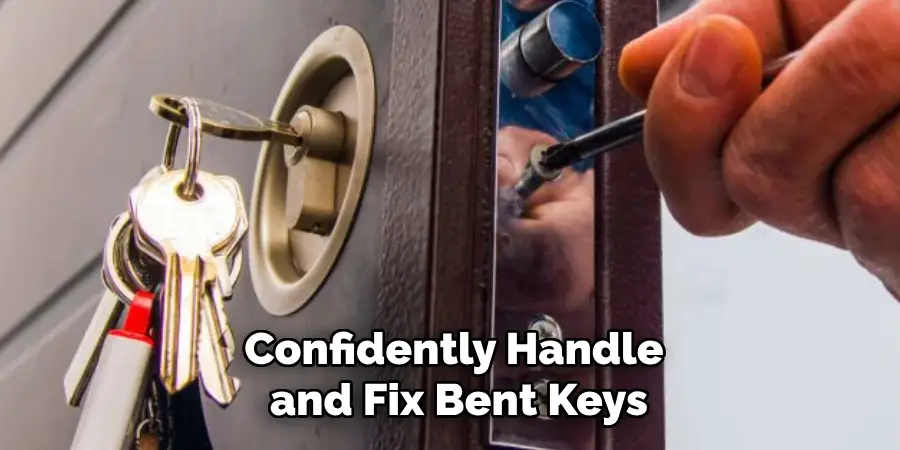A bent key can be a frustrating problem, especially if it’s the only one you have for a specific lock. Fixing it on your own can save time and money compared to getting a replacement or professional service.

This guide on how to fix a bent key will walk you through simple and effective methods to restore your key to its original shape. By following these steps, you can potentially avoid damage to the lock and regain the functionality of your key.
Why Do Keys Bend?
Keys are made of metal and can easily bend or warp due to various reasons. Some common causes include:
Regular Wear and Tear:
Keys can gradually bend over time as they are constantly inserted and removed from locks. This is especially common if you have been using the same key for a long period.
Mishandling or Forceful Use:
Accidentally forcing your key into a lock or using it to open other objects, such as bottles or cans, can cause it to bend. Additionally, using excessive force while turning the key in a lock can also lead to bending.
Extreme Temperatures:
Exposure to extreme temperatures, such as leaving your keys in a hot car or freezing temperatures during winter, can cause them to expand or contract and become bent.
8 Step-by-step Guidelines on How to Fix a Bent Key
Step 1: Assess the Damage
Before attempting to fix your bent key, carefully assess the extent of the damage. Begin by laying the key on a flat surface to determine how much it is bent. Look for any visible twists or warps along the shaft of the key. It is also important to inspect for any cracks or weak points in the metal that might break during the straightening process.
If the damage seems minor, it is more likely that you will be able to restore it to its original shape. However, if the key is severely bent, distorted, or has visible cracks, consider consulting a professional or opting for a replacement.

Step 2: Gather Your Tools
To fix a bent key, you will need some basic tools that can be found at home or easily purchased from a hardware store. These include:
- Pliers
- Vice grips
- Rubber mallet
- Hammer
Step 3: Apply Pressure with Pliers or Vice Grips
Using pliers or vice grips is one of the easiest ways to fix a bent key. Begin by placing the key between the jaws of the tool, ensuring that it is securely held in place. Then gently apply pressure to straighten out any bends along the shaft of the key.
Be careful not to exert too much force as this can cause further damage or break the key. Slowly and gradually increase the pressure until the key is straightened to your desired shape.
Step 4: Use a Rubber Mallet
A rubber mallet can be used to gently tap on the bent part of the key to straighten it out. Place the key on a flat, hard surface and hold it firmly with one hand. With your other hand, use the rubber mallet to lightly tap on the bent area in a downward motion. This will help to gradually flatten out any bends without causing damage to the metal.
It is important to note that this method may not be suitable for severe bends or cracks in the key.
Step 5: Hammer it Out
If the bend in your key is more stubborn, you can use a hammer to gently tap on the bent area. Place the key on a flat, sturdy surface and hold it firmly with one hand. Then, using a hammer, gently tap along the length of the bent part until it begins to straighten out.
Again, be cautious not to apply excessive force as this can cause damage or breakage.
Step 6: Apply Heat
Applying heat to a bent key can make it easier to manipulate and reshape, especially if the metal is particularly stubborn. To do this, you can use a lighter or a small butane torch to gently heat the area of the key that is bent. Hold the key with a pair of pliers to prevent any burns, and carefully move the flame back and forth along the bend for a few seconds. The heat will soften the metal slightly, allowing you to more easily apply pressure to straighten it.

Once heated, use pliers or a vise to gently bend the key back into place. Be cautious not to overheat the key or hold the flame in one spot for too long, as excessive heat can weaken the metal or cause discoloration. After you’ve reshaped the key, let it cool naturally before testing it in the lock.
Step 7: Test the Key
Once you have straightened the key to your satisfaction, it is crucial to test it in the corresponding lock to ensure it functions correctly. Insert the key gently into the lock and attempt to turn it. Pay attention to any resistance or difficulty in its operation. If the key turns smoothly and unlocks the mechanism without any issues, your repair has been successful.
However, if the key does not fit well or you still struggle to turn the lock, you may need to make further adjustments or consider seeking professional assistance. Testing the key after straightening helps verify that it has been effectively restored to working condition without causing potential damage to the lock.
Step 8: Add Lubrication
After successfully fixing your bent key, it is a good idea to add some lubrication to the lock and key. This will ensure smooth operation and prevent future bending or warping of the key. Apply a few drops of graphite powder or spray lubricant into the keyhole and insert the key several times to distribute it evenly.
Following these steps on how to fix a bent key can help you fix a bent key and regain access to your lock without causing further damage. Remember to be patient and careful when attempting to straighten out your key, as excessive force or heat can cause more harm than good. If the issue persists, it may be time to consider replacing the key altogether. Keep in mind that regular maintenance and proper handling of your keys can also help prevent them from becoming bent in the first place.

Additional Tips
- Regularly inspect your keys for any signs of bending or damage and address them promptly.
- Do not attempt to fix a severely damaged or cracked key at home; seek professional assistance instead.
- Avoid using excessive force when straightening out a bent key, as this can cause further damage or breakage.
- Always test the key in the corresponding lock after straightening to ensure it functions correctly.
- Lubricate your keys and locks regularly to prevent future bending or warping.
- Consider using a keychain or key organizer to keep your keys from getting bent or damaged while in your pocket or bag.
- Store spare keys in a safe and secure place, away from extreme temperatures, to avoid potential bending.
- If you notice any resistance or difficulty when turning your key in a lock, stop and assess the issue before forcing it. This could be an indication of a potential bend that needs to be addressed. continue from here…..
- If you are regularly experiencing bent keys, consider investing in a stronger and more durable type of key, such as a titanium or stainless steel key.
- Be mindful of how you handle your keys to avoid bending them. Avoid twisting or forcing the key into the lock if it does not fit smoothly.
- Keep your keys separated from other sharp objects that could potentially cause damage, such as coins or tools.
- If you live in an area with extreme weather conditions, be sure to take extra precautions to protect your keys from potential warping or bending.
- If you have children in the household, educate them on proper key handling to prevent accidents or damage.
- In case of an emergency where a bent key has caused you to be locked out, consider calling a locksmith for assistance rather than attempting to fix it yourself. Locksmiths have specialized tools and expertise i fixing bent keys and locks without causing further damage.
- Lastly, remember that prevention is key when it comes to preserving the integrity of your keys. By taking proper care and handling them with caution, you can avoid the hassle of having to fix a bent key in the first place. So, make it a habit to regularly inspect and maintain your keys for their longevity and smooth operation.
- With these tips in mind, you can confidently handle and fix bent keys whenever they occur without causing further damage or inconvenience. Remember to always prioritize safety and caution when dealing with key-related issues, and seek professional help when necessary. Happy key fixing!

Conclusion
A bent key can be an inconvenience, but with these simple steps, you can easily fix it at home without having to replace it or seek professional help. Remember to take caution when applying pressure or heat, and always test the repaired key before using it regularly. By following these guidelines on how to fix a bent key, you can restore your bent key to its original shape and ensure the smooth operation of your lock. So, next time you encounter a bent key, don’t panic – just follow these steps and get back to using your keys in no time!
